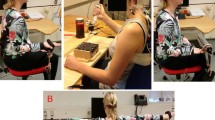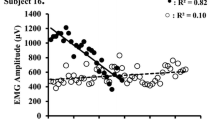Abstract
The aim of the present study was to investigate the extent to which work-related muscular disorders of the upper trapezius affect the activity of other pain-free muscles, in particular in the biceps brachii. Two groups of female subjects (age >43 years) participated in the study: seven affected subjects with self-reported disorders in the shoulder/neck region (cases) and nine healthy subjects (control group). Multi-channel electromyography (EMG) and force were recorded during maximum voluntary contractions (MVC) and during 6 min sustained contractions (at 30% MVC) of the upper trapezius and biceps brachii on the dominant side. From the EMG signals, the root mean square (RMS), median frequency (MDF) and single motor unit (MU) conduction velocity (CV) were estimated. From the force signal, the coefficient of variation was calculated. All data are presented as mean values and standard deviation. Differences between the cases and controls were found in the MVC force of the upper trapezius, which was lower in cases [253 (70) N] than in controls [357 (75) N], while the coefficient of variation of force during the sustained contraction was increased [cases 5.5 (2.2); controls 4.1 (1.9)]. The RMS (normalized to the RMS at MVC) during the 6 min sustained contractions was significantly lower in the cases than in the controls for both the upper trapezius and the biceps brachii. A tendency towards a smaller increase in the RMS with fatigue was only found in the trapezius muscle [slope: cases 6.5 (14.1) %/min, controls 10.2 (12.9) %/min]. No differences were found between the two subject groups with respect to the MDF and single MU CV in both muscles. While the lower RMS for the trapezius muscles of the cases may reflect changes at the local level, as well as in motor control, the lower biceps activity indicates a change in the central control strategies of the primarily unaffected muscle. Indications for a changed fatigability of the muscle were only found in the trapezius.





Similar content being viewed by others
References
Arendt-Nielsen L, Mills RK, Forster A (1989) Changes in muscle fibre conduction velocity, mean power frequency and mean EMG voltage during prolonged submaximal contractions. Muscle Nerve 12:493–397
Arendt-Nielsen L, Graven-Nielsen T, Svarrer H, Svensson P (1996) The influence of low back pain on muscle activity and coordination during gate. Pain 64:231–240
Ashton-Miller JA, McGlashen KM, Herzenberg JE, Stohler CS (1990) Cervical muscle myoelectric response to acute experimental sternocleidomastoid pain. Spine 15:1006–1012
Basmajian J, DeLuca CJ (1985) Muscle alive: their function revealed by electromyography. Williams and Wilkins, Baltimore
Birch L, Christensen H, Arendt-Nielsen L, Graven-Nielsen T, Søgaard G (2000) The influence of experimental muscle pain on motor unit activity during low-level contraction. Eur J Appl Physiol 83:200–206
Björklund M, Crenshaw AG, Djupsjöbacka M, Johansson H (2000) Position sense acuity is diminished following repetitive low-intensity work to fatigue in a simulated occupational setting. Eur J Appl Physiol 81:361–367
Borg G (1990) Psychophysical scaling with applications in physical work and the perception of exertion. Scand J Work Environ Health 16:55–58
Broman H, Bilotto G, DeLuca CJ (1985) Myoelectric signal conduction velocity and spectral parameters: influence of force and time. J Appl Physiol 58:1428–1437
DeLuca CJ (1984) Myoelectric manifestations of localized muscular fatigue in humans. Crit Rev Biomed Eng 11:251–279
Enoka RM, Robinson GA, Kossev AR (1989) Task and fatigue effects on low-threshold motor units in human hand muscle. J Neurophysiol 62:1344–1359
Enoka RM, Christou EA, Hunter SK, Kornatz KW, Semmler JG, Taylor AM, Tracy BL (2003) Mechanisms that contribute to differences in motor performance between young and old adults. J Electromyogr Kinesiol 13:1–12
Farina D, Kallenberg LAC, Merletti R, Hermens H (2003) Effects of side dominance on myoelectric manifestations of muscle fatigue in the human upper trapezius muscle. Eur J Appl Physiol 90:480–488
Farina D, Madeleine P, Graven-Nielsen T, Merletti R, Arendt-Nielsen L (2002) Standardising surface electromyogram recordings for assessment of activity and fatigue in the human upper trapezius muscle. Eur J Appl Physiol 86:469–478
Farina D, Schulte E, Merletti R, Rau G, Disselhorst-Klug C (2003) Single motor unit analysis from spatially filtered surface EMG signals. Part I: spatial selectivity. Med Biol Eng Comput 41:330–337
Gantchev N, Kossev A, Gydikov A, Gerasimenko Y (1992) Relation between the motor units recruitment threshold and their potentials propagation velocity at isometric activity. Electromyogr Clin Neurophysiol 32:221–228
Gowland C, deBruin H, Basmajian JV, Plews N, Burcea I (1992) Agonist and antagonist activity during voluntary upper-limb movement in patients with stroke. Phys Ther 72:624–633
Graven-Nielsen T, Arendt-Nielsen L, Svensson P, Jensen TS (1997) Effects of experimental muscle pain on muscle activity and coordination during static and dynamic motor function. Electroencephalogr Clin Neurophysiol 105:156–164
Hagberg C, Hagberg M (1998) Surface EMG amplitude and frequency dependence on exerted force for the upper trapezius muscle: a comparison between right and left sides. Eur J Appl Physiol 58:641–645
Hagberg M, Kvarnström S (1984) Muscular sustained and electromyographic fatigue in myofascial shoulder pain. Arch Phys Med Rehabil 65:522–525
Hägg GM (1991) Static work loads and occupational myalgia—a new explanation model. In: PA Anderson (ed) Electromyographical kinesiology, Excerpta Medica, Amsterdam, pp 141–144
Hägg GM (1992) Interpretation of EMG spectral alterations and alteration indices at sustained contractions. J Appl Physiol 73:1211–1217
Hägg GM, Ojok JR (1997) Isometric and isoelectric sustained tests for the upper trapezius muscle. Eur J Appl Physiol 75:263–267
Hägg GM, Suurküla J (1991) Zero crossing rate of electromyograms during occupational work and sustained test as predictors for work-related myalgia in the shoulder/neck region. Eur J Appl Physiol 62:436–444
Hansson GA, Strömberg U, Larsson B, Ohlsson K, Balogh I, Moritz U (1992) Electromyographic fatigue in neck/shoulder muscles and sustained in women with repetitive work. Ergonomics 11:1341–1352
Henneman E, Somjen G, Carpenter DO (1965) Excitability and inhibitability of motoneurons of different sizes. J Neurophysiol 28:599–620
Hermens HJ, Freriks B (1997) The state of the art on sensors and sensor placement procedures for surface electromyography: a proposal for sensor placement procedures. Report of the SENIAM Project, Roessingh Research and Development, Enschede
Hermens HJ, Van Bruggen TAM, Baten CTM, Rutten WLC, Boom HBK (1992) The median frequency of the surface EMG power spectrum in relation to motor unit firing and action properties. J Electromyogr Kinesiol 2:15–25
Houtman CJ, Stegeman DF, Van Dijk JP, Zwarts MJ (2003) Changes in muscle fiber conduction velocity indicate recruitment of distinct motor unit populations. J Appl Physiol 95:1045–1054
Jensen BR, Pilegaard M, Sjøgaard G (2000) Motor unit recruitment and rate coding in response to fatiguing shoulder abductions and subsequent recovery. Eur J Appl Physiol 83:190–199
Jensen C, Vasseljen O, Westgaard RH (1993) The influence of electrode position on bipolar surface electromyogram recordings from the upper trapezius muscle. Eur J Appl Physiol 67:266–273
Johansson H, Sojka P (1991) Pathophysiological mechanisms involved in genesis and spread of muscular tension in occupational muscle pain and in chronic musculosceletal pain syndromes: a hypothesis. Med Hypotheses 35:196–203
Lawrence JH, De Luca CJ (1983) Myoelectric signal versus force relationship in different human muscles. J Appl Physiol 54:1653–1659
Juul-Kristensen B, Kadefors R, Hansen K, Byström P, Sandsjö L, Sjøgaard G (2004) Clinical signs and physical function in neck and upper extremities among elderly female computer users: the NEW study. Eur J Appl Physiol DOI 10.1007/s00421-004-1220-4
Lund JP, Donga R, Widmer CG, Stohler CS (1991) The pain adaptation model: a discussion of the relationship between chronic musculoskeletal pain and motor activity. Can J Physiol Pharmacol 69:683–694
Madeleine P, Lundager B, Voigt M, Arendt-Nielsen L (1999) Shoulder muscle co-ordination during chronic and acute experimental neck-shoulder pain. An occupational pain study. Eur J Appl Physiol 79:127–140
Madeleine P, Farina D, Merletti R, Arendt-Nielsen L (2002) Upper trapezius muscle mechanomyographic and electromyographic activity in humans during low force fatiguing and non-fatiguing contractions. Eur J Appl Physiol 87:327–336
Masuda T, DeLuca CJ (1991) Technique for detecting MUAP propagation from high-threshold motor units. J Electromyogr Kinesiol 1:75–80
Masuda T, Miyano H, Sadoyama T (1985) The position of innervation zones in the biceps brachii investigated by surface electromyography. IEEE Trans Biomed Eng 32:36–42
Mathiassen SE, Winkel J, Hägg GM (1995) Normalization of surface EMG amplitude from the upper trapezius muscle in ergonomic studies—a review. J Electromyogr Kinesiol 4:197–226
Mathiassen SE, Burdorf A, van der Beek AJ (2002) Statistical power and measurement allocation in ergonomic intervention studies assessing upper trapezius EMG amplitude. A case study of assembly work. J Electromyogr Kinesiol 12:45–57
Maton B, Gamet D (1989) The fatigability of two agonistic muscles in human isometric voluntary submaximal contraction: an EMG study. II. Motor unit firing rate and recruitment. Eur J Appl Physiol Occup Physiol 58:369–374
Merletti R, Knaflitz M, DeLuca CJ (1990) Myoelectric manifestations of fatigue in voluntary and electrically elicited contractions. J Appl Physiol 69:1810–1820
Merletti R, Lo Conte L, Cisari C, Actis MV (1992) Age related changes in surface myoelectric signals. Scand J Rehabil Med 24:25–36
Merletti R, Farina D, Gazzoni M, Schieroni MP (2002) Effect of age on muscle functions investigated with surface electromyography. Muscle Nerve 25:65–76
Moritani T, Muro M, Nagata A (1986) Intramuscular and surface electromyogram changes during muscle fatigue. J Appl Physiol 60:1179–1185
Öberg T, Sandsjö L, Kadefors R, Larsson SE (1992) Electromyographic changes in work-related myalgia of the trapezius muscle. Eur J Appl Physiol 65:251–257
Olsen HB, Christensen H, Søgaard K (2001) An analysis of motor unit firing pattern during sustained low force contraction in fatigued muscles. Acta Physiol Pharmacol Bulg 26:73–78
Pedersen J, Lonn J, Hellstrom F, Djupsjöbacka M, Johansson H (1999) Localized muscle fatigue decreases the acuity of the movement sense in the human shoulder. Med Sci Sports Exerc 31:1047–1052
Schulte E, Farina D, Rau G, Merletti R, Disselhorst C (2003) Single motor unit analysis from spatially filtered surface EMG signals. Part II: conduction velocity estimation. Med Biol Eng Comput 41:338–345
Sjøgaard G, Søgaard K, Hermens HJ, Sandsjö L, Läubli T, Thorn S, Vollenbroek-Hutton MMR, Sell L, Christensen H, Klipstein A, Kadefors R, Merletti R (2005) Neuromuscular assessment in Elderly Workers from four EU countries with and without work related musculoskeletal disorders. The NEW-study design and physiological findings. Eur J Appl Physiol (in press)
Svensson P, Arendt-Nielsen L, Houe L (1995) Sensory-motor interactions of human experimental unilateral jaw muscle pain: a quantitative analysis. Pain 64:241–249
Takala EP, Viikari-Juntura E (1991) Muscle force, sustained and neck-shoulder symptoms of sedentary workers. An experimental study on bank cashiers with and without symptoms. Int J Ind Ergonom 7:123–132
Acknowledgements
This work has been supported by the European Shared Cost Project ‘Neuromuscular Assessment of Elderly Workers’ (NEW) (QLRT-2000–00139).
Author information
Authors and Affiliations
Corresponding author
Rights and permissions
About this article
Cite this article
Schulte, E., Kallenberg, L.A.C., Christensen, H. et al. Comparison of the electromyographic activity in the upper trapezius and biceps brachii muscle in subjects with muscular disorders: a pilot study. Eur J Appl Physiol 96, 185–193 (2006). https://doi.org/10.1007/s00421-004-1291-2
Accepted:
Published:
Issue Date:
DOI: https://doi.org/10.1007/s00421-004-1291-2




